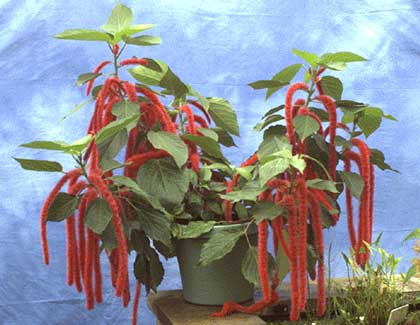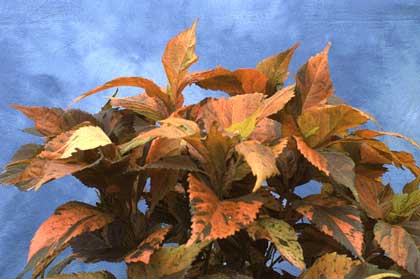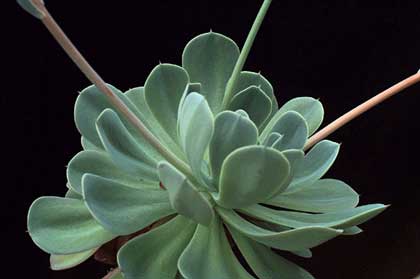Subclass Rosidae
Subclass Rosideae is large with 58000 species, and in evolutionary terms it has derived features such as pinnately compound leaves. Familiar members of the subclass include legumes (peas, beans, etc), spurges, Eucalyptus, evening primroses, roses, maples, grapes, geraniums, carrots, strawberries, apples, cherries, and raspberries.
 Euphorbiaceae: Spurge family
Euphorbiaceae: Spurge family
Contains 7500 species of cosmopolitan distribution, but best developed in tropical and subtropical regions. Many members are economically important, including the rubber tree Hevea brasiliensis, of which there is a specimen in the Glasshouse. There is also a collection of African Euphorbiaceae, which are succulents ecologically comparable to cacti.
Right: Acalypha hispida, the chenille plant, has pendulous catkin-like female inflorescences with dense mats of crimson styles. It was first collected in New Guinea in 1896 and is now cultivated all over the tropics.
Below: Acalypha wilksiana variagata. Acalypha is a large genus of the Euphorbiaceae with 400 species; most species are grown for their variegated foliage and have insignificant flowers.

Crassulaceae: Stonecrop family
 Family of 900 species of succulents, from which is named crassulacean acid metabolism (CAM), an adaptation of CO2-fixation to dry habitats. Cosmopolitan distribution in arid, temperate or warm-temperate regions, but especially diversified in South Africa, Mexico and Asia. More than two-thirds of species belong to the general Sedum, Crassula or Kalanchoe. Right: the fleshy leaves characteristic of this family can be seen on this flowering specimen of Echeveria elegans.
Family of 900 species of succulents, from which is named crassulacean acid metabolism (CAM), an adaptation of CO2-fixation to dry habitats. Cosmopolitan distribution in arid, temperate or warm-temperate regions, but especially diversified in South Africa, Mexico and Asia. More than two-thirds of species belong to the general Sedum, Crassula or Kalanchoe. Right: the fleshy leaves characteristic of this family can be seen on this flowering specimen of Echeveria elegans.
